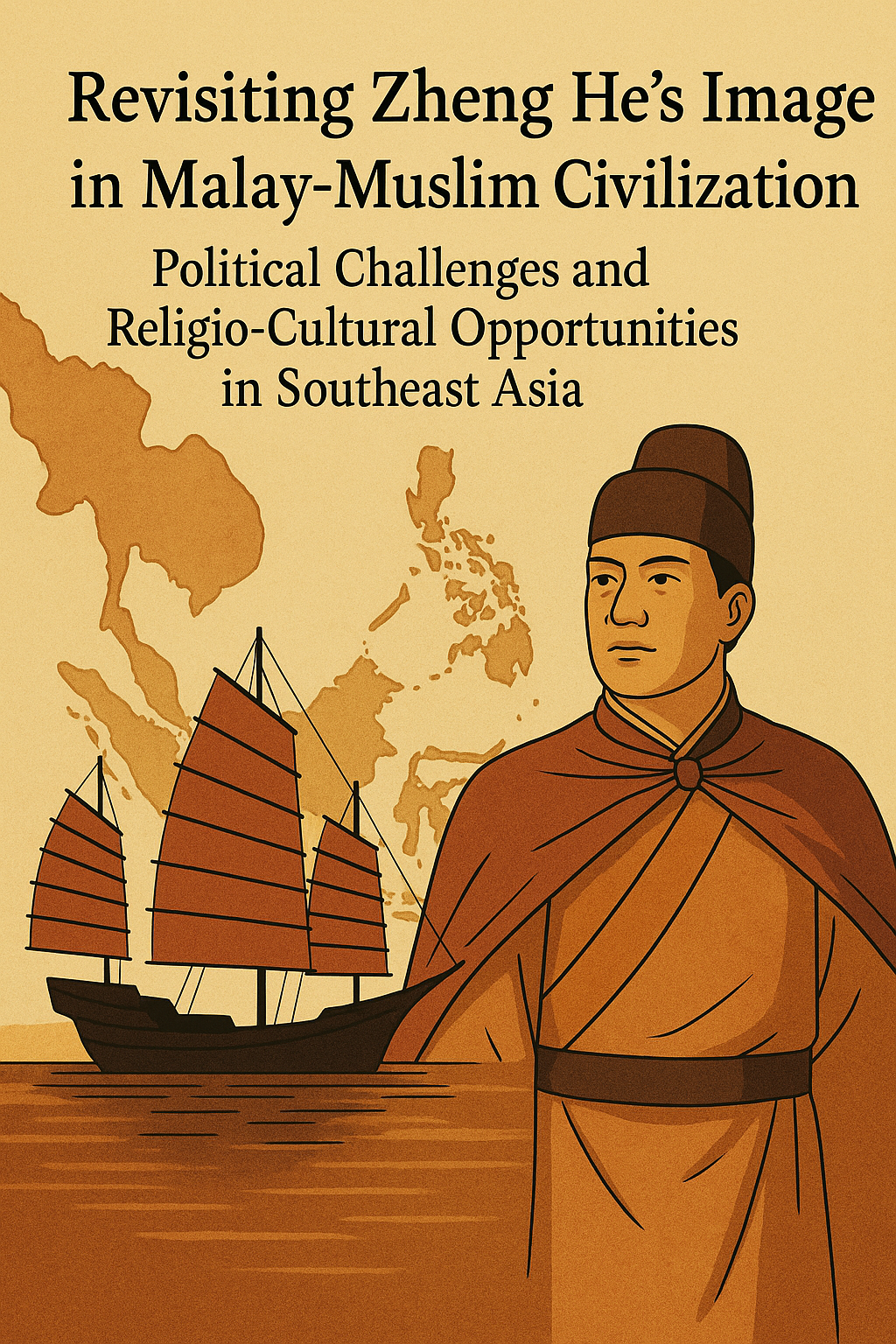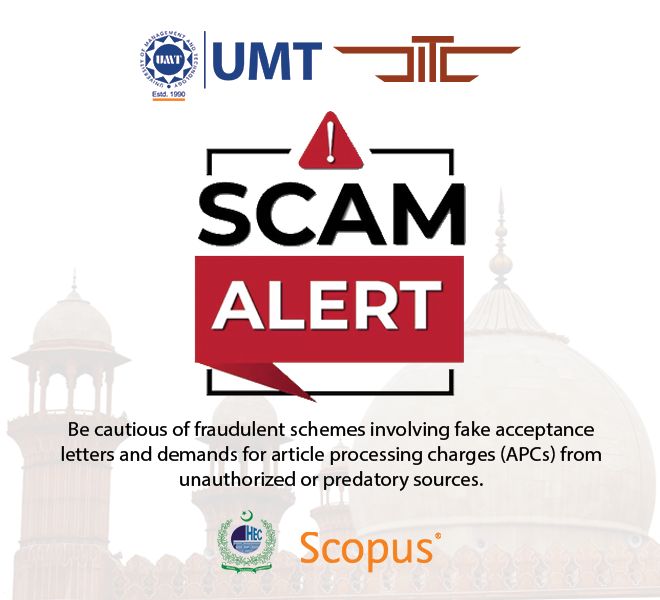Revisiting Zheng He’s Image in Malay-Muslim Civilization: Political Challenges and Religio-Cultural Opportunities in Southeast Asia
Abstract
 Abstract Views: 0
Abstract Views: 0
In recent decades, the Chinese government has increasingly promoted Admiral Zheng He – known in Southeast Asia as Cheng Ho - as a symbol of peaceful diplomacy and intercultural harmony, embedding this image within its broader soft power strategy in the Muslim world. However, this diplomatic initiative intersects with complex regional realities in Southeast Asia, where religious identity, historical memory, and cultural sovereignty are deeply rooted. This article revisits Zheng He’s image within the context of Malay-Muslim civilization, with particular attention to Indonesia and Malaysia, highlighting its relevance to contemporary political and religio-cultural dynamics. Adopting a multidisciplinary approach that integrates historical analysis, civilizational studies, and regional geopolitics, the article explores how Zheng He’s legacy is perceived, reinterpreted, and contested among Malay-Muslim communities. The findings reveal a dual dynamic: on the one hand, Zheng He’s legacy offers opportunities to strengthen cultural diplomacy, economic collaboration, and interfaith dialogue in Southeast Asia; on the other hand, it presents challenges related to local political sensitivities, religious identity, and historical contestation. While Zheng He provides a shared historical reference point fostering inter-civilizational dialogue and religious tolerance, his symbolic usage also raises critical questions about political motives, cultural authenticity, and historical appropriation. Ultimately, this article contributes to a more critical understanding of how historical figures are mobilized within modern geopolitical narratives and their implications for identity politics in Muslim-majority regions of Southeast Asia. More broadly, the article offers insights for Chinese policymakers and states engaged in diplomacy with China.
Downloads
References
Al Qurtuby, Sumanto. “The Imprint of Zheng He and Chinese Muslims in Indonesia’s Past.” In Zheng He and the Afro-Asian World, edited by Chia Lin Sien and Sally K. Church, 171–86. Melaka: Melaka Museums Corporation (PERZIM), 2012.
—. “The Tao of Islam: Zheng He and the Legacy of Chinese Muslims in Pre-Modern Java.” Studia Islamika 16, no. 1 (2009): 51–78.
Al-Attas, Syed Muhammad Naquib. Historical Fact and Fiction. Kuala Lumpur: UTM Press, 2011.
—. Islam dalam Sejarah dan Kebudayaan Melayu [Islam in Malay History and Culture]. Kuala Lumpur: Universiti Kebangsaan Malaysia, 2022.
Bharti, Mukesh Shankar., and Suprabha Kumari. “China’s Belt and Road Initiative in Southeast Asia and Its Implications for ASEAN-China Strategic Partnership.” Asian Review of Political Economy 3, no. 1 (2024): Article e2. https://doi.org/10.1007/s44216-024-00042-4.
Cai, Yunci. "Rethinking Heritage Diplomacy on the Maritime Silk Road." In The Museum in Asia: Imagining the Cultural Nation, edited by Yunci Cai and Jack Loh, 206–20. London: Routledge, 2025.
Callahan, William A. “History, Tradition and the China Dream: Socialist Modernization in the World of Great Harmony.” Journal of Contemporary China 24, no. 96 (2015): 983–1001. https://doi.org/10.1080/10670564.2015.1030915.
Chaffee, John W. Zheng He and the Afro-Asian World, 1415–2021. Singapore: National University of Singapore Press, 2018.
Chia, Claudia Yi En., and Liao Bo Wen. “A Comparative Study of India and China’s Cultural Diplomacy in Southeast Asia.” In India and China in Southeast Asia, edited by Amit Ranjan, Diotima Chattoraj, and A. K. M. Ahsan Ullah, 91–113. Singapore: Springer Nature Singapore, 2024, https://doi.org/10.1007/978-981-97-6903-2_5.
Dreyer, Edward L. Zheng He: China and the Oceans in the Early Ming Dynasty, 1405–1433. New York: Pearson Longman, 2007.
Edeh, Emmanuel Chidiebere., and Cang Cong Zhao. “Cultural Practices as Part of Socioeconomic Development Strategies in One Belt One Road: A Conceptual Insight.” East Asia 39, no. 2 (2022): 181–198. https://doi.org/10.1007/s12140-021-09374-x.
Effendi, Tonny Dian. “Zheng He and International Relations: An Asian Cultural Diplomacy Model.” Journal of Integrative International Relations 4, no. 2 (2019): 115–128, https://doi.org/10.15642/jiir.2019.4.2.115-128.
Fitri Rofiyarti. “Popularity and Representation of Zheng He’s Image: Pre-Preliminary Research.” Journal of Integrative International Relations 5, no. 1 (2020): 27–36. https://doi.org/10.15642/jiir.2020.5.1.27-36.
Fitriana, Tiara Rijayanti, and Tiara Isfiaty. “Cultural Acculturation in the Interior of Cheng Ho Pandaan Mosque in East Java.” Proceedings of the 7th International Conference on Business, Economics, Social Sciences, and Humanities, vol. 7 (Bandung: Universitas Komputer Indonesia, 2024), 147–56. https://doi.org/10.34010/3n6k5w09.
Gong, Xue. “The Belt and Road Initiative and China’s Influence in Southeast Asia.” The Pacific Review 32, no. 4 (2019): 635–665, https://doi.org/10.1080/09512748.2018.1513950.
Gramsci, Antonio. Selections from the Prison Notebooks. Edited and translated by Quintin Hoare and Geoffrey Nowell Smith. London: Lawrence & Wishart, 1971.
Gungwu, Wang. The Chinese Overseas: From Earthbound China to the Quest for Autonomy. Cambridge: Harvard University Press, 1998.
—. The Maritime Silk Road: History, Politics and Heritage. London: Routledge, 2021.
Hasanah, Eva Putriya, Moh Ali Aziz, Sokhi Huda, and Hepi Fauzi. "Cheng Ho Mosque and Social Status: A Study on the Existence of Chinese Muslim within Sociocultural Relations in Surabaya, Indonesia." Harmoni 21, no. 2 (2022): 201–216. https://doi.org/10.32488/harmoni.v21i2.637.
Holder, Ross. "On the Interrelatedness of Human Rights, Culture and Religion: Considering the Significance of Cultural Rights in Protecting the Religious Identity of China's Uyghur Minority." The International Journal of Human Rights 25, no. 5 (2021): 771–792. https://doi.org/10.1080/13642987.2020.1725487.
Holmes, James R., and Toshi Yoshihara. “Soft Power at Sea: Zheng He and Chinese Maritime Strategy.” Proceedings Magazine, U.S. Naval Institute, October 2006, https://www.usni.org/magazines/proceedings/2006/october/soft-power-sea-zheng-he-and-chinese-maritime-strategy?.
Holmes, James R. “‘Soft Power’ at Sea: Zheng He and China’s Maritime Diplomacy.” Southeast Review of Asian Studies 28 (2006): 95–107.
Hrubý, Jakub. “Establishing a Common Ground — Admiral Zheng He as an Agent of Cultural Diplomacy in Malaysia.” In Transnational Sites of China’s Cultural Diplomacy, edited by Jarmila Ptáčková and Zdenka Švarcová, 89–113. Singapore: Springer, 2020.
Huan, Ma. Ying-Yai Sheng-Lan: The Overall Survey of the Ocean’s Shores (1433). Edited by Feng Ch’eng-Chün. Translated by J. V. G. Mills. Cambridge: Hakluyt Society, 1970.
Jeofrey, Siti Adibah Binti Mohmad., and M. Zaki. “Islamic Law and Customary Law in the Prohibition of Sogit Marriage in Sabah, Malaysia.” Islamic Law and Social Issues in Society 1, no. 1 (2025): 85–96. https://doi.org/10.64929/ilsiis.v1i1.8.
Kong, Da. Museums, International Exhibitions and China's Cultural Diplomacy. London: Routledge, 2021.
Kurlantzick, Joshua. Charm Offensive: How China’s Soft Power Is Transforming the World. New Haven: Yale University Press, 2007.
Lim, Tai Wei. “The Cheng Ho (Zheng He) Cultural Museum in Malacca (Melaka): Its Historical Importance and Contemporary Symbolisms.” Asian Journal of Comparative Politics 3, no. 3 (2018): 232–245, https://doi.org/10.1177/2057891117746768.
Luhuringbudi, Teguh, Wilnan Fatahillah, Amin Muhtar, Mowafg Abrahem Masuwd, and Safa Husayn Alrumayh. The Impact of the US-China Trade War on the Application of Islamic Law in Indonesia.” Islamic Law and Social Issues in Society 1, no. 1 (2025): 1–23, https://doi.org/10.64929/ilsiis.v1i1.12
Mahfud, Choirul. “The Role of Cheng Ho Mosque: The New Silk Road, Indonesia-China Relations in Islamic Cultural Identity.” Journal of Indonesian Islam 8, no. 1 (2014): 23–38.
McDougall, Derek. The International Politics of the New Asia Pacific. Boulder: Lynne Rienner Publishers, 2011.
Mills, J. V. G. “Introduction and Notes to Ying-yai Sheng-lan: The Overall Survey of the Ocean’s Shores (1433).” In Ying-yai Sheng-lan, by Ma Huan. Cambridge: Hakluyt Society, 1970.
Mutia, R. Tuty Nur., and Reynaldo de Archellie. “Reassessing China’s Soft Power in Indonesia: A Critical Overview on China’s Cultural Soft Power.” Cogent Arts and Humanities 10, no. 1 (2023): Article e2178585, https://doi.org/10.1080/23311983.2023.2178585.
Nye, Joseph S. Jr. Soft Power: The Means to Success in World Politics. New York: Public Affairs, 2004.
Pratisti, Siti Aliyuna., Deasy Silvya Sari, and Taufik Hidayat. “Zheng He’s Soft Power Discourse in Indonesia: Identity in Power Relation.” Economics, Politics and Regional Development 1, no. 1 (2020): 64–71. http://dx.doi.org/10.22158/eprd.v1n1p64.
Ptak, Roderich. China and the Asian Seas: Trade, Travel and Visions of the Other (1400–1750). London: Routledge, 1998.
Rahmawati, Rahmawati, Kasim Yahiji, Choirul Mahfud, Jauharoti Alfin, and Much Koiri. “Chinese Ways of Being Good Muslim: From the Zheng Heo Mosque to Islamic Education and Media Literacy.” Indonesian Journal of Islam and Muslim Societies 8, no. 2 (2018): 225–252.
Rohman, Abid. “Chinese Indonesian Cultural and Religious Diplomacy.” Journal of Integrative International Relations 4, no. 1 (2019): 1–21, https://doi.org/10.15642/jiir.2019.4.1.1-21.
Sen, Tan Ta. Cheng Ho and Islam in Southeast Asia. Singapore: ISEAS Publishing, 2009.
Sen, Tansen. “Inventing the ‘Maritime Silk Road.’” Modern Asian Studies 57, no. 4 (2023): 1059–1104, https://doi.org/10.1017/S0026749X22000348.
Suko Susilo, Eva Putriya Hasanah., and Nur Syam. “Motif Pembangunan Masjid Zheng He Surabaya [The Motives Behind the Construction of Zheng He Mosque in Surabaya].” Tribakti: Jurnal Pemikiran Keislaman 32, no. 2 (2021): 367–382.
Tien, Ngu Ik., and Ngeow Chow Bing. “Soft Power, Confucius Institute and China’s Cultural Diplomacy in Malaysia.” Kajian Malaysia 39, no. 1 (2021): 55–76.
Tritto, Angela, and Punto Wijayanto. “The Maritime Silk Road: Tourism, Heritage, Symbols and the People-to-People Dimension of China’s ‘Heritage Diplomacy’ in Indonesia.” In Heritage Conservation and China’s Belt and Road Initiative, edited by Victor C. M. Chan, Yew-Foong Hui, Desmond Hui, and Kazem Vafadari, 160–75. London: Routledge, 2023.
Wade, Geoff. “The Zheng He Voyages: A Reassessment.” Journal of the Malaysian Branch of the Royal Asiatic Society 78, no. 1 (2005): 37–58.
Widodo, Johannes. “A Celebration of Diversity: Zheng He and the Origin of the Pre-Colonial Coastal Urban Pattern in Southeast Asia.” In Admiral Zheng He and Southeast Asia: China’s Maritime Diplomacy, edited by Leo Suryadinata, 94–123. Singapore: ISEAS Publishing, 2005.
Winter, Tim. “Silk Road Diplomacy: Geopolitics and Histories of Connectivity.” International Journal of Cultural Policy 26, no. 7 (2020): 898–912. https://doi.org/10.1080/10286632.2020.1765164
Weatherbee, Donald E. International Relations in Southeast Asia: The Struggle for Autonomy. Lanham: Rowman & Littlefield, 2009.
Yuanzhi, Khong. “On the Relationship between Cheng Ho and Islam in Southeast Asia.” Kyoto Review of Southeast Asia, no. 10 (2008). https://kyotoreview.org/issue-10/on-the-relationship-between-cheng-ho-and-islam-in-southeast-asia/

Copyright (c) 2025 Zikwan, Edi Kurniawan

This work is licensed under a Creative Commons Attribution 4.0 International License.

This work is licensed under a Creative Commons Attribution 4.0 International License. Authors retain copyright and grant the journal right of first publication with the work simultaneously licensed under a Creative Commons Attribution (CC-BY) 4.0 License that allows others to share the work with an acknowledgement of the work’s authorship and initial publication in this journal.







